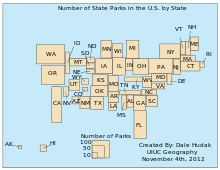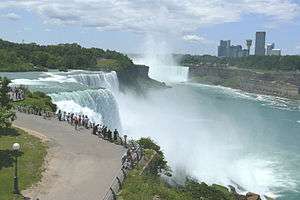State park
State or provincial parks are parks or other protected areas managed at the sub-national level within those nations which use "state" or "province" as a political subdivision. State parks are typically established by a state to preserve a location on account of its natural beauty, historic interest, or recreational potential. There are state parks under the administration of the government of each U.S. state, and of some the Mexican states. The term is also used in the Australian state of Victoria.[1] The Canadian equivalent term is provincial park. Similar systems of local government maintained parks exist in other countries, but the terminology varies.
State parks are thus similar to national parks, but under state rather than federal administration. Similarly, local government entities below state level may maintain parks, e.g., regional parks or county parks. In general, state parks are smaller than national parks, with a few exceptions such as the Adirondack Park in New York and Anza-Borrego Desert State Park in California.
State parks by country
United States of America
As of 2014, there were 10,234 state park units in the United States, according to the National Association of State Park Directors (NASPD).[2] California alone has 278.[3] There are some 739 million annual visits to the country's state parks.[2] The NASPD further counts over 43,000 miles (69,000 km) of trail, 217,367 campsites, and 8,277 cabins and lodges across U.S. state parks.[2]

Many states include designations beyond "state park" in their state parks systems. Other designations might be state recreation areas, state beaches, and state nature reserves. Some state park systems include long-distance trails and historic sites.
History
The title of oldest state park in the United States is claimed by Niagara Falls State Park in New York, established in 1885.[4][5] However several public parks previously or currently maintained at the state level pre-date it.[6] Indian Springs State Park has been operated continuously by the state of Georgia as a public park since 1825, although it did not gain the title "State Park" until 1931.[7] In 1864 Yosemite Valley and Mariposa Grove were ceded by the federal government to California[6] until Yosemite National Park was proclaimed in 1890.[8] In 1878 Wisconsin set aside a vast swath of its northern forests as "The State Park" but, needing money, sold most of it to lumber companies within 20 years.[9] The first state park with the designation of "state park" was Mackinac Island State Park in 1895, which was first a national park before being transferred to the state of Michigan.[10]
Many state park systems date to the 1930s, when around 800 state parks across the country were developed with assistance from federal job creation programs like the Civilian Conservation Corps and Works Progress Administration.[11]
See also
| Wikimedia Commons has media related to State parks. |
- List of U.S. state parks
- National Association of State Park Directors
- Wilderness preservation systems in the United States
- State park (Brazil)
- Provincial park (Canada)
References
- ↑ "Collaborative Australian Protected Area Database (CAPAD) - Terrestrial Protected Areas in Australia by Type (2014) (refer "TYPE" tab)". Department of the Environment (DoE). Retrieved 16 April 2016.
- 1 2 3 "State Park Facts". National Association of State Park Directors. Retrieved 2016-10-08.
- ↑ "Parks by the Numbers" (PDF). California State Parks Quick Facts. California State Parks. 2009-12-07. Retrieved 2011-05-19.
- ↑ Niagara Frontier State Parks & Recreation Commission. "The Niagara Reservation - A Historical Perspective". New York State Office of Parks, Recreation & Historic Preservation. Retrieved 2011-05-13.
- ↑ "Niagara Falls State Park". New York State Office of Parks, Recreation & Historic Preservation. Retrieved 2016-10-08.
- 1 2 Edmondson, Brad (2001). "Publication #72 - Environmental Affairs in New York State: A Historical Overview" (PDF). New York State Archives. pp. 7–9. Retrieved 2016-10-08.
- ↑ "Indian Springs State Park". Georgia Department of Natural Resources. Retrieved 2009-08-07.
- ↑ "Yosemite National Park: Stories". National Park Service. 2011-01-19. Retrieved 2011-05-20.
- ↑ "Wisconsin State Parks through the Years". Wisconsin Department of Natural Resources. Retrieved 2011-05-20.
- ↑ "Mackinac Island State Park". Mackinac Island State Park Commission. Retrieved 2011-05-13.
- ↑ Don (2006-01-09). "The monument builders - CCC: The Depression-era corps built roads, parks and bridges, and now people are raising money for a monument to them". Duluth News Tribune. Duluth, Minn.
Further reading
- Ahlgren, Carol. "The Civilian Conservation Corps and Wisconsin State Park Development." Wisconsin Magazine of History (1988): 184-204. in JSTOR
- Landrum, Ney C. The State Park Movement in America: A Critical Review (2013) excerpt and text search
- Larson, Zeb. "Silver Falls State Park and the Early Environmental Movement." Oregon Historical Quarterly (2011) 112#1 pp: 34-57 in JSTOR
- Newton, Norman T. "The State Park Movement: 1864-1933;" and "State Parks and the Civilian Conservation Corps, Parkways and Their Offspring." in Design on the Land: the Development of Landscape Architecture (Harvard UP 1971)
- Parker, Eugene Phillip. "When Forests Trumped Parks: The Maryland Experience, 1906-1950." Maryland Historical Magazine (2006) 101#2 pp: 203-224.

.jpg)



